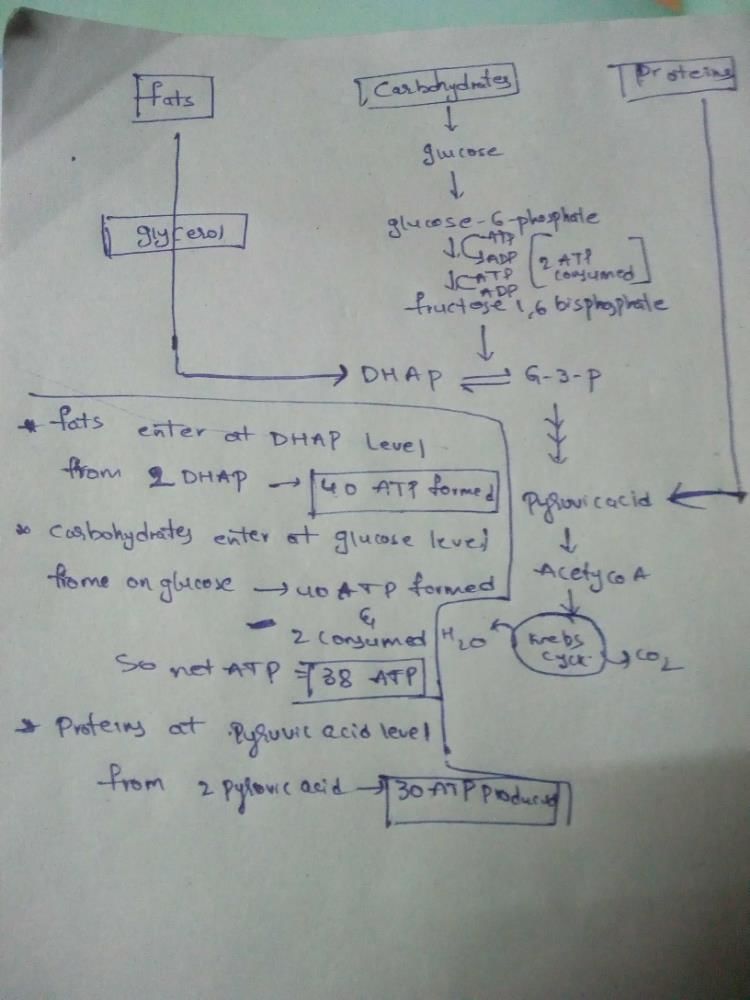NEET Exam > NEET Questions > Maximum amount of energy/ATP is liberated on ...
Start Learning for Free
Maximum amount of energy/ATP is liberated on oxidation of [1994]
- a)fats
- b)proteins
- c)starch
- d)vitamins
Correct answer is option 'A'. Can you explain this answer?
Verified Answer
Maximum amount of energy/ATP is liberated on oxidation of [1994]a)fats...
Fats are used as respiratory substrates by a number of organisms because they contain more energy as compared to carbohydrates.
Most Upvoted Answer
Maximum amount of energy/ATP is liberated on oxidation of [1994]a)fats...
Maximum amount of energy/ATP is liberated on oxidation of Fats [1994]Fats are known to be the most efficient source of energy in the human body. The process of oxidation of fats results in the release of a large amount of energy, which is used to produce ATP, the energy currency of the body.Why fats are the best source of energy?- High energy content: Fats contain more than twice the amount of energy compared to carbohydrates and proteins.- Long-term energy storage: Fats are stored in adipose tissue, which can provide energy for a long time.- Efficient metabolism: The oxidation of fats produces more ATP per molecule than the oxidation of carbohydrates or proteins.How is energy released from fats?- Lipolysis: The breakdown of fats into free fatty acids and glycerol, which can be transported to the mitochondria.- Beta-oxidation: The breakdown of fatty acids into acetyl-CoA, which enters the Krebs cycle and produces ATP.- Electron transport chain: The final step in ATP production, which occurs in the mitochondria and involves the transfer of electrons from NADH and FADH2 to oxygen, resulting in the production of ATP.Conclusion:Therefore, it can be concluded that fats are the most efficient source of energy in the human body as they contain a high energy content, are stored for long-term energy, and produce more ATP per molecule compared to carbohydrates and proteins.
Free Test
FREE
| Start Free Test |
Community Answer
Maximum amount of energy/ATP is liberated on oxidation of [1994]a)fats...


|
Explore Courses for NEET exam
|

|
Question Description
Maximum amount of energy/ATP is liberated on oxidation of [1994]a)fatsb)proteinsc)starchd)vitaminsCorrect answer is option 'A'. Can you explain this answer? for NEET 2025 is part of NEET preparation. The Question and answers have been prepared according to the NEET exam syllabus. Information about Maximum amount of energy/ATP is liberated on oxidation of [1994]a)fatsb)proteinsc)starchd)vitaminsCorrect answer is option 'A'. Can you explain this answer? covers all topics & solutions for NEET 2025 Exam. Find important definitions, questions, meanings, examples, exercises and tests below for Maximum amount of energy/ATP is liberated on oxidation of [1994]a)fatsb)proteinsc)starchd)vitaminsCorrect answer is option 'A'. Can you explain this answer?.
Maximum amount of energy/ATP is liberated on oxidation of [1994]a)fatsb)proteinsc)starchd)vitaminsCorrect answer is option 'A'. Can you explain this answer? for NEET 2025 is part of NEET preparation. The Question and answers have been prepared according to the NEET exam syllabus. Information about Maximum amount of energy/ATP is liberated on oxidation of [1994]a)fatsb)proteinsc)starchd)vitaminsCorrect answer is option 'A'. Can you explain this answer? covers all topics & solutions for NEET 2025 Exam. Find important definitions, questions, meanings, examples, exercises and tests below for Maximum amount of energy/ATP is liberated on oxidation of [1994]a)fatsb)proteinsc)starchd)vitaminsCorrect answer is option 'A'. Can you explain this answer?.
Solutions for Maximum amount of energy/ATP is liberated on oxidation of [1994]a)fatsb)proteinsc)starchd)vitaminsCorrect answer is option 'A'. Can you explain this answer? in English & in Hindi are available as part of our courses for NEET.
Download more important topics, notes, lectures and mock test series for NEET Exam by signing up for free.
Here you can find the meaning of Maximum amount of energy/ATP is liberated on oxidation of [1994]a)fatsb)proteinsc)starchd)vitaminsCorrect answer is option 'A'. Can you explain this answer? defined & explained in the simplest way possible. Besides giving the explanation of
Maximum amount of energy/ATP is liberated on oxidation of [1994]a)fatsb)proteinsc)starchd)vitaminsCorrect answer is option 'A'. Can you explain this answer?, a detailed solution for Maximum amount of energy/ATP is liberated on oxidation of [1994]a)fatsb)proteinsc)starchd)vitaminsCorrect answer is option 'A'. Can you explain this answer? has been provided alongside types of Maximum amount of energy/ATP is liberated on oxidation of [1994]a)fatsb)proteinsc)starchd)vitaminsCorrect answer is option 'A'. Can you explain this answer? theory, EduRev gives you an
ample number of questions to practice Maximum amount of energy/ATP is liberated on oxidation of [1994]a)fatsb)proteinsc)starchd)vitaminsCorrect answer is option 'A'. Can you explain this answer? tests, examples and also practice NEET tests.

|
Explore Courses for NEET exam
|

|
Signup for Free!
Signup to see your scores go up within 7 days! Learn & Practice with 1000+ FREE Notes, Videos & Tests.























